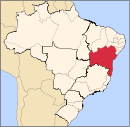Salvador, Bahia
Salvador | |
|---|---|
| Município de Salvador Municipality of Salvador | |
 From the top: Farol da Barra Lighthouse, Ponta de Santo Antonio, southern end of town. Featured, the Barra Lighthouse, Buildings Facades in the Harbor at Salvador, Lacerda Elevator, The monument to the heroes of the battles of Independence of Bahia, panoramic view of the city. | |
|
| |
| Nickname(s): Roma Negra (Black Rome) and Soterópolis | |
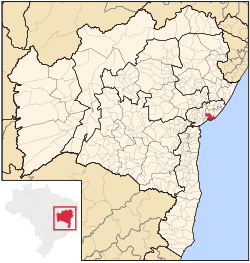 Location of Salvador in the State of Bahia | |
| Country | |
| Region | Northeast |
| State | |
| Founded | 29 March 1549 |
| Government | |
| • Mayor | Antônio Carlos Magalhães Neto DEM |
| Area | |
| 693 km2 (268 sq mi) | |
| Elevation | 8 m (26 ft) |
| Population (2014) | |
| 2,902,927 (3rd) | |
| • Density | 4,187/km2 (10,840/sq mi) |
| • Metro | 3,919,864 (7th)[1] |
| Time zone | UTC-3 |
| Postal Code | 40000-000 |
| Area code | +55 71 |
| Website | Salvador, Bahia |
Salvador, formerly São Salvador da Bahia de Todos os Santos ("Holy Savior of the Bay of All Saints") and known colloquially as Bahia or Salvador da Bahia (Portuguese pronunciation: [sawvaˈdoʁ (da baˈi.ɐ)][2]),[3][4] is the largest city and the third-largest urban agglomeration on the northeast coast of Brazil and the capital of the Northeastern Brazilian state of Bahia.
The first colonial capital of Brazil, the city is one of the oldest in the Americas.[5] Salvador is the third most populous Brazilian city, after São Paulo and Rio de Janeiro. The metropolitan area of the city, with 3.5 million people, however, is the eighth[6] most populous Brazilian urban agglomeration, and the third in Northeastern Brazil.[7] Salvador is known as "Brazil's capital of happiness" due to its countless popular outdoor parties, including its street carnival. The city has the largest carnival in the world.[8]
The city of Salvador is notable in Brazil for its cuisine, music and architecture, and its metropolitan area is the wealthiest in Brazil's Northeast. The African influence in many cultural aspects of the city makes it the centre of Afro-Brazilian culture. This reflects a situation in which African-associated cultural practices are celebrated.[9]
The Historic Centre of Salvador, frequently called the "Pelourinho", is renowned for its Portuguese colonial architecture with historical monuments dating from the 17th to the 19th centuries and was declared a World Heritage Site by UNESCO in 1985.[10]
Salvador is located on a small, roughly triangular peninsula that separates All Saints Bay from the open waters of the Atlantic Ocean. The bay, which gets its name from having been discovered on All Saints' Day forms a natural harbor, the bay is the largest in Brazil and the second largest in the World.[11] Salvador is a major export port, lying at the heart of the Recôncavo Baiano, a rich agricultural and industrial region encompassing the northern portion of coastal Bahia.[12]
A particularly notable feature is the escarpment that divides Salvador into the Cidade Alta ("Upper Town" - rest of the city) and the Cidade Baixa ("Lower Town" - port area and apart neighborhoods along the bay), the former some 85 m (279 ft) above the latter,[13] with the city's cathedral and most administrative buildings standing on the higher ground. An elevator (the first installed in Brazil), known as Elevador Lacerda, has connected the two sections since 1873, having since undergone several upgrades.[14]
Salvador is home of the 3rd best beach of the World, Porto da Barra Beach, in Barra neighborhood, elected in 2007 by the British Newspaper The Guardian,[15] and also is home of the Arena Fonte Nova, the city's stadium in the World Cup.[16] The city hosted in 2010, an important international event, the Twelfth United Nations Congress on Crime Prevention and Criminal Justice.[17]
The city is one of the host cities of the 2014 FIFA World Cup. Additionally, Salvador hosted the 2013 FIFA Confederations Cup.
History

Portuguese Empire 1549–1815
Dutch West India Company 1624–1625
United Kingdom of PBA 1815–1823
Empire of Brazil 1823–1889
Republic of Brazil 1889–present

Baía de Todos os Santos (All Saints Bay) was first encountered by the Portuguese and named in 1500. In 1501, one year after the arrival of Pedro Álvares Cabral's fleet in Porto Seguro, Gaspar de Lemos arrived at Todos os Santos Bay and sailed most of the Bahia coast. But the first European man to disembark on "Morro de São Paulo", Saint Paul's Mount, was Martim Afonso de Sousa, in 1531, leading an expedition to explore the coast of the new continent.[18]
In 1549, a fleet of Portuguese settlers headed by Thomé de Souza, the first Governor-General of Brazil, established Salvador. Built on a high cliff overlooking All Saints bay as the first colonial capital of colonial Brazil, it quickly became its main sea port and an important center of the sugar industry and the slave trade.[19]
The general failure of the captaincy system spurred the Portuguese Crown (in the person of Dom João III) into setting up a governorship of Brazil to be led by Thomé de Souza. De Souza arrived in Bahia on 29 March, in 1549, and he went to work building a capital for Brazil and a place for himself to live (or for the governor-general to live and administrate from, rather). The latest incarnation of his palace, now called Palácio Rio Branco, sits on a commanding position overlooking the bay, on the same public square giving onto the Elevador Lacerda which takes one down to the lower city. The palace, in all its neo-classical glory, is open to the public.[20]
Salvador was, however, primarily influenced by Catholicism; it became the seat of the first Catholic bishopric of Brazil in 1552[21] and is still a center of Brazilian Catholicism.
Salvador was divided into an upper and a lower city, the upper one being the administrative and religious area and where the majority of the population lived. The lower city was the financial center, with a port and market. In the late 19th Century, funiculars and an elevator, the Elevador Lacerda, were built to link the two areas.[22]

Salvador was the capital city of the Portuguese viceroyalty of Grão-Pará and its province of Baía de Todos os Santos. The Dutch admiral Piet Hein of the West Indian Company captured and sacked the city in May 1624, and held it along with other north east ports until it was retaken by a Spanish-Portuguese fleet in May 1625. It then played a strategically vital role in the Portuguese-Brazilian resistance against the Dutch.
Salvador was the first capital of Brazil and remained so until 1763, when it was succeeded by Rio de Janeiro. It settled into graceful decline over the next 150 years, out of the mainstream of Brazilian industrialization. It remains, however, a national cultural and tourist center. By 1948 the city had some 340,000 people, and was by then Brazil's fourth largest city. In 2010 it had 2,676,606 people in the city proper, the third largest population in Brazil.
In the 1990s, a major city project cleaned up and restored the old downtown area, the Pelourinho, or Centro Historico ("Historical Center"). Now, the Pelourinho is a cultural center, and the heart of Salvador's tourist trade. Nonetheless, this social prophylaxis resulted in the forced removal of thousands of working class residents to the city's periphery where they have encountered significant economic hardship.[23]
Additionally, the Historical Center is now something of a depopulated architectural jewel whose "animation" must be brought in and sponsored by local shopowners and the Bahian state. Similar situations may be found in many UNESCO World Heritage Sites today but the Pelourinho, in light of Salvador's economic inequalities and ruling governmental coalitions of the 1990s, seems to have gone farther than most in sacrificing its population to the needs of tourist-based preservation.[24]
Climate
Salvador features a tropical rainforest climate (Köppen: Af) with no discernible dry season due to no month having an average rainfall of 60 mm. Temperatures are relatively constant throughout the course of the year,[25] featuring warm and humid conditions.[26] Salvador's driest month of the year is September, where the city receives on average 10 cm (4 in) of precipitation. Salvador's wettest months are between April and June when at least 20 cm (8 in) of rain falls during each of these four months.[27] Template:Weatherbox Salvador, Bahia
Demographics




According to the 2010 IBGE Census, there were 2,480,790 people residing in the city of Salvador.[28] The census revealed the following numbers: 1,382,543 Pardo (Multiracial) people (51.7%), 743,718 Black people (27.8%), 505,645 White people (18.9%), 35,785 Asian people (1.3%), 7,563 Amerindian people (0.3%).[29]
In 2010, the city of Salvador was the 3rd most populous city in Brazil, after São Paulo and Rio de Janeiro.[30]
In 2010, the city had 474,827 opposite-sex couples and 1,595 same-sex couples. The population of Salvador was 53.3% female and 46.7% male.[29]
Most of the population is in part descended from Black African enslaved individuals, who were mainly Yoruba speakers from Nigeria, Ghana, Togo and Benin.[31]
According to an autosomal DNA study from 2008, the ancestral heritage of the population of Salvador was estimated to be 49.20% African, 36.30% European and 14.50% Native American.[32]
Population growth
- Changing demographics of the city of Salvador

Source: Planet Barsa Ltda.[33]
Religion
| Religion | Percentage | Number |
|---|---|---|
| Catholic | 51.55% | 1,379,252 |
| Protestant | 19.59% | 524,286 |
| No religion | 17.64% | 471,928 |
| Spiritist | 3.23% | 86,484 |
| Umbanda and Candomblé | 1.05% | 28,019 |
| Jewish | 0.04% | 1,010 |
Economy
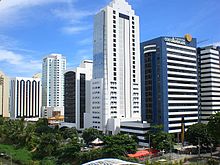
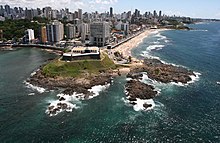


Throughout Brazilian history Salvador has played an important role. Because of its location on Brazil's northeastern coast, the city served as an important link in the Portuguese empire throughout the colonial era, maintaining close commercial ties with Portugal and Portuguese colonies in Africa and Asia.[35]
Salvador remained the preeminent city in Brazil until 1763 when it was replaced as the national capital by Rio de Janeiro. In the last ten years many high-rise office and apartment buildings were constructed, sharing the same blocks with colonial-era housing or commercial buildings.[36]
With its beaches, humid tropical climate, numerous up-to-date shopping malls (The Shopping Iguatemi was the first Shopping in Northeastern Brazil and Salvador Shopping is one of the most modern in the World) and pleasant high-class residential areas, the city has much to offer its residents. Economically Salvador is one of Brazil's more important cities. Since its founding the city has been one of Brazil's most prominent ports and international trading centers. Boasting a large oil refinery, a petrochemical plant and other important industries, the city has made great strides in reducing its historical dependence on agriculture for its prosperity.[37]
Salvador is the second most popular tourism destination in Brazil, after Rio de Janeiro.[38] Tourism and cultural activity are important generators of employment and income, boosting the arts and the preservation of artistic and cultural heritage.
Chief among the points of interest are its famous Pelourinho (named after the colonial pillories that once stood there) district, its historic churches,[39] and its beaches. Salvador's tourism infrastructure is considered one of the most modern in World, especially in terms of lodging. The city offers accommodation to suit all tastes and standards, from youth hostels to international hotels. Construction is one of the most important activities in the city, and many international (mainly from Spain, Portugal and England)[40] and national developers are investing in the city and in the Bahian littoral zone.
Ford Motor Company has a plant in the Metropolitan Region of Salvador, in the city of Camaçari, assembling the Ford EcoSport, Ford Fiesta, Ford Fiesta Sedan.[41] It was the first Automotive industry in Northeastern Brazil. The industry employs 800 engineers.[42]
JAC Motors will have a plant in the Metropolitan Region of Salvador, in the city of Camaçari, the new industry will result 3,500 direct jobs and 10,000 indirect jobs, the production of 100,000 vehicles by year.[43]
In December 2001, Monsanto Company inaugurated, at the Petrochemical Pole of Camaçari, in Metropolitan Region of Salvador, the first plant of the company designed to produce raw materials for the herbicide Roundup in South America. The investment is equivalent to US$500 millions; US$350 millions were spent in this initial phase. The Camaçari Plant, the largest unit of Monsanto outside of the United States, is also the only Monsanto plant manufacturing raw materials for the Roundup production line. The company started the civil works for the new plant in January 2000.[44]
| Economy[45][46] | GDP (in reais) | GDP per capita (in reais) |
|---|---|---|
| 2013 | 38,819,520,000 | 14,411.73 |
Tourism and recreation




The Salvador coastline is one of the longest for cities in Brazil. There are 80 km (50 mi) of beaches distributed between the High City and the Low City, from Inema, in the railroad suburb to the Praia do Flamengo, on the other side of town. While the Low City beaches are bordered by the waters of the All Saints Bay (the country's most extensive bay), the High City beaches, from Farol da Barra to Flamengo, are bordered by the Atlantic Ocean. The exception is Porto da Barra Beach, the only High City beach located in the All Saints Bay.
The big hotels tend to be strung out along the orla (Atlantic seafront). There are also smaller hotels in Barra and Porto da Barra, others (generally less expensive) scattered along the principal thoroughfare of Avenida Sete de Setembro (shortened to "Avenida Sete" by the locals), and still others (usually inexpensive) in and around Pelourinho.[48]
There are also pousadas (guest houses, or bed and breakfasts) in Barra, Pelourinho, and Santo Antônio (and other places as well, to be sure), and hostels (albergues), which are for the most part located in Pelourinho (though a lot of the "pousadas" in Barra are hostels as well).[49]
The capital's beaches range from calm inlets, ideal for swimming, sailing, diving and underwater fishing, as well as open sea inlets with strong waves, sought by surfers. There are also beaches surrounded by reefs, forming natural pools of stone, ideal for children.
Interesting places to visit near Salvador include:
- According to the British newspaper The Guardian, in 2007, Porto da Barra Beach was the third best in the world.[50]
- The large island of Itaparica in the Bay of All Saints can be visited either by a car-ferry, or a smaller foot-passenger ferry, which leaves from near the Mercado Modelo near the Lacerda Elevator.
- BA-099 Highway, or "Line of Coconut" and "Green Line" of towns and cities, with exquisite beaches, north of Salvador heading towards Sergipe state.
- Morro de São Paulo in the Valença region across the Bay of All Saints – an island that can be reached by ferry from Salvador (2 hours), by plane, or by bus to Valença and then by 'Rapido' ('fast') speedboat or smaller ferry. Morro de São Paulo is formed by five villages of the Tinharé Island.
The city is served by many shopping malls: Shopping Iguatemi, Salvador Shopping, Shopping Barra, and Shopping Paralela.
Salvador has four parks, green areas protected, as Jardim dos Namorados Park, Costa Azul Park, Park of the City, Park of Pituaçu.
Jardim dos Namorados is located right next to Costa Azul Park and occupies an area of 15 hectares in Pituba, where many families used to spend their vacations in the 1950s. It was inaugurated in 1969, initially as a leisure area. It underwent a complete renovation in the 1990s, with the construction of an amphitheater with room for 500 people, sports courts, playgrounds and parking for cars and tourist buses.

Park of the City is an important preservation area of the Atlantic forest. It was completely renovated in 2001, becoming a modern social, cultural and leisure place. The new park has 720 square meter of green area right in the middle of the city. Among the attractions are Praça das Flores (Flowers square), with more than five thousand ornamental plants and flowers.
Besides its environment, the park has an infrastructure for children, with a special schedule of events taking place every October.[51]
Created by state decree in 1973, Pituaçu Park occupies an area of 450 hectares and is one of the few Brazilian ecological parks located in an urban area. It is surrounded by Atlantic forest, with a good variety of plants and animals. There is also an artificial pond in the park, built in 1906 along with the Pituaçu Dam, whose purpose was to supply water to the city.[52]
There are a number of possible leisure activities, ranging from cycloboats rides on the pond, to a 38 km (24 mi) long cycloway circling the entire reserve. A museum is also located in the park. Espaço Cravo is an outdoor museum with 800 pieces created by Mario Cravo, comprising Totems, winged and three-dimensional figures, as well as drawings and paintings.
Education


There are international schools, such as the Pan American School of Bahia.
Educational institutions
The city has several universities:
- Universidade Federal da Bahia (UFBA) (Federal University of Bahia);
- Universidade Católica do Salvador (UCSal) (Catholic University of Salvador);
- Universidade do Estado da Bahia (UNEB) (Bahia State University);
- Universidade Salvador (UNIFACS) (Salvador University);
- Faculdade de Tecnologia e Ciências (FTC) (College of Technology and Science);
- Instituto Federal da Bahia (IFBA) (Federal Institute of Bahia);
- Faculdade Ruy Barbos] (FRB) (Ruy Barbosa College);
- Faculdade Castro Alve] (FCA) (Castro Alves College);
- Faculdade Jorge Amado (FJA) (Jorge Amado College);
- Escola Bahiana de Medicina e Saúde Pública (EBMSP) (Bahian School of Medicine and Public Health);
The city has several language schools of Portuguese for foreigners and English for locals.
Primary and secondary schools
Top high schools of the city are São Paulo Academy, Anchieta Academy, Oficina Academy, Federal Institute of Bahia (IFBA), Social Institute of Bahia (ISBA), Cândido Portinari Academy, Antônio Vieira Academy, Módulo Academy, Military College of Salvador, Sartre Coc Academy, Integral Academy, 2 de Julho Academy, Nossa Senhora da Conceição Academy, Gregor Mendel Academy, Nossa Senhora das Mercês Academy, São José Academy.
- Based on the ranking of Enem of 2011[53]
Historic Centre
| UNESCO World Heritage Site | |
|---|---|
 | |
| Criteria | Cultural: iv, vi |
| Reference | 309 |
| Inscription | 1985 (9th Session) |
The Historic Centre of Salvador was designated in 1985 a World Heritage Site by UNESCO. The city represents a fine example the Portuguese urbanism from the middle of the 16th century with its higher administrative town and its lower commercial town, and a large portion of the city has retained the old character of its streets and colourful houses.
As the first capital of Portuguese America, Salvador cultivated slave labor and had its "pelourinhos" pillories installed in open places like the terreiro de Jesus and the squares know today as Thomé de Souza and Castro Alves. The "pelourinho" was a symbol of authority and justice, for some, and lashings and injustice for the majority.[54] The one erected for a short time in what is now the Historical Center, and later moved to what is now the Praça da Piedade (Square of Piety), ended up lending its name to the historical and architectural complex of Pelourinho, part of the city's historical center.
Since 1992, the Pelourinho neighborhood has been subject to a nearly US$100 million "restoration" that has led to the rebuilding of hundreds of buildings' façades and the expulsion of the vast majority of the neighborhood's Afro-descendent population. This process has given rise to substantial political debate in the State of Bahia, since the Pelourinho's former residents have been for the most part excluded from the renovation's economic benefits (reaped by a few). A major restoration effort resulted in making the area a tourist attraction.[55]
Salvador's considerable wealth and status during colonial times (as capital of the colony during 250 years and which gave rise to the Pelourinho) is reflected in the magnificence of its colonial palaces, churches and convents, most of them dating from the 17th and 18th centuries. These include:
- Cathedral of Salvador: Former Jesuit church of the city, built in the second half of the 17th century. Fine example of Mannerist architecture and decoration.
- Convent and Church of São Francisco: Franciscan convent and church dating from the first half of the 18th century is another fine example of the Portuguese colonial architecture. The Baroque decoration of the church is among the finest in Brazil.
- Church of Nosso Senhor do Bonfim: Rococo church with Neoclassical inner decoration. The image of Nosso Senhor do Bonfim is the most venerated in the city, and the Feast of Our Lord of Good Ending (Festa de Nosso Senhor do Bonfim) in January is the most important in the city after Carnival.
- Mercado Modelo (Model Market): In 1861, at the Cayrú Square, the Customs Building was constructed, with a rotunda (large circular room with a domed ceiling) at the back end, where ships anchored to unload their merchandise.
- Elevador Lacerda (Lacerda Elevator): Inaugurated in 1873, this elevator was planned and built by the businessman Antônio Francisco de Lacerda, The four elevator cages connect the 72 metres (236 ft) between the Thomé de Souza Square in the upper city, and the Cayru Square in the lower city. In each run, which lasts for 22 seconds, the elevator transports 128 persons, 24 hours a day.
Culture
Salvador's historical and cultural aspects were inherited by the intermarriage of such ethnic groups as Native-Indian, African and European. This mixture can be seen in the religion, cuisine, cultural manifestations, and custom of Bahia's people.
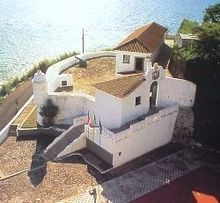
Literature

Gregório de Mattos, born in Salvador in 1636, was also educated by the Jesuits. He became the most important Baroque poet in colonial Brazil for his religious and satirical works. Father António Vieira was born in Lisbon in 1608, but was raised and educated in the Jesuit school of Salvador and died in the city in 1697. His erudite sermons have earned him the title of best writer of the Portuguese language in the Baroque era.[56]
After the Independence of Brazil (1822), Salvador continued to play an important role in Brazilian literature. Significant 19th century writers associated with the city include Romantic poet Castro Alves (1847–1871) and diplomat Ruy Barbosa (1849–1923). In the 20th century, Bahia-born Jorge Amado (1912–2001), although not born in Salvador, helped popularize the culture of the city around the world in novels such as Jubiabá, Dona Flor e Seus Dois Maridos, and Tenda dos Milagres, the settings of which are in Salvador.[57]
Religion
In Salvador, religion is a major contact point between Portuguese and African influences and, in the last 20 years, Brazil's version of a North American-influenced Pentecostalism.[58] Salvador was the seat of the first bishopric in colonial Brazil (established 1551), and the first bishop, Pero Fernandes Sardinha, arrived already in 1552.[59] The Jesuits, led by the Manuel da Nóbrega, also arrived in the 16th century and worked in converting the Indigenous peoples of the region to Roman Catholicism.

Many religious orders came to the city, following its foundation: Franciscans, Benedictines and Carmelites. Subsequently to them are created the Third Orders, the Brotherhoods, and Fraternities, which were composed mainly of professional and social groups. The most prominent of these orders were the Terceira do Carmo Order and the de São Francisco Order, founded by white men, and the Nossa Senhora do Rosário and São Beneditino Brotherhoods, composed of black men.[60] In many churches maintained by religious men, were housed the Santíssimo Sacramento brotherhoods.
Besides these organizations, the expansion of Catholicism in the city was consolidated through social care work. Santa Casa the Misericórdia was one of the institution that did this kind of work, maintaining hospitals, shelters for the poor and the elderly, as well providing assistance to convicts and to those who would face death penalties.[60] The convents, on their part, were cultural and religious formation centers, offering seminar coursed that often were attended by the lay.
Even with the present evolution, and the growth of Protestantism and other religions in the city, the Catholic faith remains as one of its most distinctive features, drawing a lot of people to its hundreds of churches. Some aspects, like the use of Portuguese in the Masses, the simplification of the liturgy, and the adoption of "pop" religious songs are key factors to the triumph of Catholicism. In the Nossa Senhora do Rosário dos Pretos Church, Masses are held in the Yorubá language, making use of African chants and typical clothes, which attract many people from the African Brazilian communities.[60]
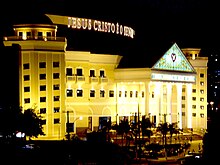

Most enslaved Africans in Bahia were brought from Sub-Saharan Africa, especially the Yoruba-speaking nation (Iorubá or Nagô in Portuguese) from present-day Nigeria. The enslaved were forced to convert to Roman Catholicism, but their original religion Yorùbá was combined with Roman Catholicism to make the syncretic religion known as, Candomblé, which has survived in spite of prohibitions and persecutions. The enslaved Africans managed to preserve their religion by attributing the names and characteristics of their Yorùbá deities to Catholic saints with similar qualities. Still today all Candomble sessions are conducted in Yoruba, not Portuguese.
These religious entities have been syncretised with some Catholic entities. For instance, Salvador's Feast of Bonfim, celebrated in January, is dedicated to both Our Lord of Bonfim (Jesus Christ) and Oxalá. Another important feast is the Feast de Yemanja every 2 February, on the shores of the borough of Rio Vermelho in Salvador, on the day the church celebrates Our Lady of the Navigators. 8 December, Immaculate Conception Day for Catholics, is also commonly dedicated to Yemanja' with votive offerings made in the sea throughout the Brazilian coast.[61]

Cuisine
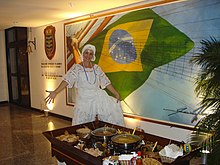
The local cuisine, spicy and based on seafood (shrimp, fish), strongly relies on typically African ingredients and techniques, and is much appreciated throughout Brazil and internationally. The most typical ingredient is azeite-de-dendê, an oil extracted from a palm tree (Elaeis guineensis) brought from West Africa to Brazil during colonial times.[62]
Using the milky coconut juice, they prepared a variety of seafood based dishes, such as Ensopados, Moquecas and Escabeche. The sugar cane bagasse was mixed with molasses and Rapadura, in the creation of coconut desserts like Cocada Branca and Preta. The remaining of the Portuguese Stew sauce was mixed with manioc flour to make a mush, which is a traditional Indian dish.[63] In the markets of Salvador, it is possible to find stands selling typical dishes of the colonial era. In the Sete Portas Market, customers eat Mocotó on Friday nights since the 1940s, when the market was inaugurated. In the restaurants of Mercado Modelo (Model Market), Sarapatel, stews and several fried dishes are served regularly. In the São Joaquim, Santa Bárbara and São Miguel markets, there are stands selling typical food. They are also sold at stands located on the beaches, specially crab stews and oysters. The restaurants that sell typical dishes are located mostly along the coast and in Pelourinho. They prepare a wide variety of recipes that take palm tree oil.
Traditional dishes include caruru, vatapá, acarajé, bobó-de-camarão, moqueca baiana, and abará. Some of these dishes, like the acarajé and abará, are also used as offerings in Candomblé rituals. An acarajé is basically a deep-fried "bread" made from mashed beans from which the skins have been removed (reputedly feijão fradinho "black-eyed peas" but in reality almost always the less expensive brown beans so ubiquitous in Bahia). But Salvador is not only typical food. Other recipes created by the slaves were the Haussá Rice (rice and jerked beef cooked together), the Munguzá, used as offering to the Candomblé deity Oxalá (who is the father of all deities, according to the religion) pleased the matrons very much. So did the Bolinhos the Fubá, the Cuscuz (cornmeal) and the Mingau (porridge). According to Arany Santana, the African Ipetê (used in the rituals to the deity Oxum) became the Shrimp bobó, and the Akará (honoring the deities Xangô and Iansã) became the world-famous Acarajé. The city has restaurants specialized on international cuisine also. There are also places that serve dishes from other states of Brazil, especially from Minas Gerais and the Northeast region.
Capoeira
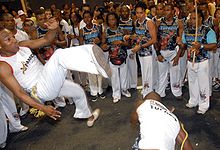
Capoeira is a unique mix of dance and martial art of Afro-Brazilian origin, combining agile dance moves with unarmed combat techniques. Capoeira in Portuguese literally means "chicken coop". The presence of capoeira in Brazil is directly connected to the importation of African slaves by the Portuguese, and Salvador is considered the centre of origin of the modern capoeira branches.[64] In the first half of the 20th century, Salvador-born masters Mestre Bimba and Mestre Pastinha founded capoeira schools and helped standardise and popularise the art in Brazil and the world. The practice of Capoeira was banned in 1892, though in 1937 it was made legal.[65] In recent years, Capoeira has become more international and accessible even in Salvador.
Museums

The artistic, cultural and social heritage of Salvador is preserved in museums. From Museu de Arte da Bahia (MAB), which is the oldest in the State, to Museu Náutico, the newest, the first capital of Brazil displays unique pieces of history.
Museu de Arte da Bahia has paintings, Chinese porcelain, furniture and sacra images from the 17th and 18th centuries. Museu Costa Pinto has private, owned items such as, pieces of art, crystal objects, furniture from the 18th and 19th centuries.
Another important museum is Museu da Cidade, where many items that help to preserve the heritage of old Salvador are kept.
Some churches and monasteries also have museums located in their premises. Examples of this are the Carmo da Misericórdia and São Bento Museums. After the renovation of the Forts, were created Museu Náutico, in Forte de Santo Antonio da Barra (Farol da Barra) and Museu da Comunicação, in Forte São Diogo. Other important museums that are scattered through Salvador are: Museu do Cacau, Museu geológico do Estado, Museu tempostal, Solar do Ferrão, Museu de Arte Antiga e Popular Henriqueta M Catharino, Museu Eugênio Teixeira Leal, Museu Rodin Bahia and Museu das Portas do Carmo.
Public art
The streets of Salvador are decorated with numerous murals and sculptures, many of which have been produced by the resident artist Bel Borba, a native of the city.[66]
Carnival/Carnaval



According to the Guinness Book of Records, the carnival or Carnaval of Salvador da Bahia is the biggest party on the planet. For an entire week, almost 4 million people celebrate throughout 25 kilometers (16 mi) of streets, avenues and squares. The direct organization of the party involves the participation of over 100,000 people.[67] Its dimensions are gigantic. Salvador receives an average of over 800,000 visitors.
The cover was done by 4,446 professionals in local press, national, and international. The carnival was broadcast to 135 countries through 65 radio stations, 75 magazines, 139 producers of video, 97 newspapers (21 international), 14 tv stations, and 168 websites.[68]
Rei Momo: The King of Carnival, Momo, is handed the keys to the city in the morning, on the Thursday before Fat Tuesday, and the party officially begins. Camarotes: These grandstands line the street in the neighborhood of Campo Grande. Watch the show from here without being trampled by the crowd. Trios Eléctricos: Outfitted with deafening sound systems, these 60-foot-long trucks carry a kick line of gyrating, scantily clad dancers along with the city's best-loved performers, among them Ivete Sangalo, Daniela Mercury, Cláudia Leitte, Chiclete com Banana, Carlinhos Brown, and others.[69]
The music played during Carnaval includes Axé and Samba-reggae. Many "blocos" participate in Carnaval, the "blocos afros" like Malé Debalé, Olodum and Filhos de Gandhi being the most famous of them. Carnival is heavily policed. Stands with five or six seated police officers are erected everywhere and the streets are constantly patrolled by police groups moving in single file.
The Osmar Circuit: goes from Campo Grande to Castro Alves square, The Downtown Circuit, in Downtown and Pelourinho, and The Dodô Circuit; goes from Farol da Barra to Ondina, along the coast. The Osmar circuit is the oldest circuit. It is also where the event's most traditional groups parades. In Dodô, where the artist box seats are located, the party becomes lively toward the end of the afternoon and it continues until morning.
The three Carnival Circuits are:
- The Campo Grande - Praça Castro Alves Circuit, also called the "Osmar" Circuit, or simply the "Avenidas" ("Avenues");
- The Barra - Ondina Circuit, also called the "Dodô" Circuit;
- The Pelourinho Circuit, also called the "Batatinha" ("Little potato") Circuit.
Funk and Bahia funk dances
The music played in Salvador at a Black Bahia Funk Ball is more American than its counterpart in Rio de Janeiro. Music material from Rio, which sells reasonably well around Rio, is poorly known in Salvador and, in any case, held to be inferior and "less modern" than funk sung in English. Another difference can be seen with the funk dancehalls. The Ball incorporates the entire setting, which entails the attire, the slang, the specific way of dancing break, the decoration, the organization of permanent dance groups.[70]
Libraries

The first books that arrived in Salvador, were brought by the Jesuits, who came with Tomé de Souza.[71] The first libraries or bookstores that appeared were under the control of the religious missionaries and were mostly composed of books on religion.
Handcraft
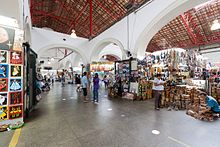
The handcraft legacy of Bahia using only raw materials (straw, leather, clay, wood, seashells and beads), the most rudimentary crafts are reasonably inexpensive. Other pieces are created with the use of metals like gold, silver, copper and brass. The most sophisticated ones are ornamented with precious and semi-precious gems. The craftsmen and women generally choose religion as the main theme of their work.[72]
They portray the images of Catholic saints and Candomble deities on their pieces. The good luck charms such as the clenched fist, the four-leaf clover, the garlic and the famous Bonfim ribbons express the city's religious syncretism. Nature is also portrayed on these pieces, reflecting the local wildlife. Music appears in the atabaque drums, the rain sticks, the water drums and the famous berimbau, along with other typical instruments.[73]
Salvador holds an international reputation as a city where musical instruments that produce unique sounds are made. These instruments are frequently used by world-famous artists in their recording sessions. The main handcrafts production in Salvador is located in Mercado Modelo, which is the biggest handcraft center in Latin America.[74]
Pieces can also be purchased at Instituto de Artesanato de Mauá and at Instituto do Patrimônio Artístico e Cultural (IPAC). These are organizations that promote typical art in Bahia.
Transportation
International Airport

Deputado Luís Eduardo Magalhães International Airport is located in an area of 6.9 thousand square meters between sand dunes and native vegetation. The airport is located 28 km (17 mi) north of Downtown Salvador and the road to the airport has already become one of the city's main scenic attractions.[75]
Port

With cargo volume that grows year after year following the same economic development rhythm implemented in the State, the Port of Salvador, located in the Bahia de Todos os Santos, holds status as the port with the highest movement of containers of the North/Northeast and the second-leading fruit exporter in Brazil.
Metro

Salvador Metro System is in operation since 2014, and its 1st phase was ready since March 2008, between Lapa and Acceso Norte Stations, and in 2009 was ready the metro stations between Acceso Norte and Pirajá. In 2014 the system had 12.5 km (7.8 mi) and 8 stations and have link with the bus system.
The main shareholders in Metro Salvador are the Spanish companies Construcciones y Auxiliar de Ferrocarriles, Dimetronic, and ICF. It is expected that Metro Salvador will invest US$150 million in rolling stock and signalling and telecommunications equipment. The contract covers the first 11.9 km (7.4 mi) line from Pirajá to Lapa, which is due to open in 2003. The project is also financed by a US$150 million World Bank loan and contributions from the federal, Bahia state, and Salvador city governments.[76]
Salvador Metro system was one of the actions of urban mobility to the 2014 FIFA World Cup. The connection of Line 2 with Line 1 of Salvador Metro contributes to connect the International Airport to Downtown Salvador and the Fonte Nova Stadium. The new Line 2 of Salvador Metro integrates the metro stations of the Rótula do Abacaxi and the beach city of Lauro de Freitas in the metropolitan area, passing through the Salvador International Airport, with the Airport metro station.[77]
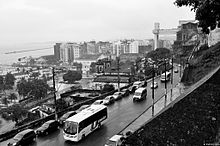
Highways
The BR-101 and BR-116 federal highways cross Bahia from north to south, connecting Salvador to the rest of the country. At the Feira de Santana junction, take the BR-324 state highway. The capital of Bahia is served by several coach companies from almost every Brazilian state. BR-242, starting at São Roque do Paraguaçu (transversal direction), is linked to BR-116, bound to the middle–west region. Among the state highways stands BA-099, which makes connection to the north coast and BA-001, which makes connection to the south of Bahia. Buses provide direct service to most major Brazilian cities, including Rio de Janeiro, São Paulo, and Brasília, as well as regional destinations. In 2007, the city had 586,951 vehicles, the largest number of the Northern and Northeastern Brazil.[79] Salvador has 2,500 public buses, and 2 million people are transported every day.[80]
The bus station or Rodoviária of Salvador is located in Iguatemi district, with direct buses to larger cities in the country and to many destinations in the state of Bahia. On the second floor exixts the counters of the different bus companies, on the first floor there is a small supermarket and a 24 hours left luggage. Across the street there is a large shopping center, Iguatemi, with a food court, connected by a pedestrian crossing.[81]
Four paved highways connect the city to the national highway system. Running north from the Farol (lighthouse) de Itapoã are hundreds of miles of wonderful beaches. These beaches are accessible via the BA-099 Highway or (Line of Coconut and Green Line), a (toll) road, kept in excellent condition, running parallel to the coast, with access roads leading off to the coast itself. The road runs along dunes of snow-white sand, and the coast itself is an almost unbroken line of coconut palms. The communities along this coast range from fishing villages to Praia do Forte.
Neighborhoods

Although the creation of Salvador was masterminded by the Kingdom of Portugal and its project conducted by the Portuguese engineer Luís Dias (who was responsible for the city's original design), the continuous growth of the capital through the decades was completely spontaneous. The walls of the city-fortress could not hold the expansion of the city, towards the Carmo and the area where now stands Castro Alves Square. At the time of its foundation, Salvador had only two squares and the first neighborhood ever built here was the Historic City Center. Pelourinho and Carmo came subsequently, created as a consequence of the growing need of space that the religious orders had. With the rapid expansion, the neighborhoods grew and many of them were clustered in the same area, so today there are not accurate records as to their exact number. For urban management purposes, the city is currently divided on 17 political-administrative zones. However, due to their very cultural relevance and to postal conveniences, the importance of the neighborhoods of Salvador remains intact.[82]

Salvador is divided into a number of distinct neighborhoods, with the most well known districts being Pelourinho, the Historic Centre, Comércio, and Old Downtown, all located in West Zone. Barra, with its Farol da Barra, beaches and which is where one of the Carnival circuits begins, Barra is home of the Portuguese Hospital and Spanish Hospital, the neighborhood is located in South Zone. Vitória, a neighborhood with many high rise buildings, is located in South Zone. Campo Grande, with its Dois de Julho Square and the monument to Bahia's independence, is also located in South Zone, as is Graça, an important residential area. Ondina, with Salvador's Zoobotanical Garden and the site where the Barra-Ondina Carnival circuit ends, the neighborhood is home of the Spanish Club, is also a neighborhood in the South Zone.
Itaigara, Pituba, Horto Florestal, Caminho das Árvores, Loteamento Aquárius, Brotas, Stiep, Costa Azul, Armação, Jaguaribe and Stella Maris are the wealthiest and the New Downtown neighborhoods in the East Zone and the city. Rio Vermelho, a neighborhood with a rich architectural history and numerous restaurants and bars, is located in the South Zone. Itapoã, known throughout Brazil as the home of Vinicius de Moraes and for being the setting of the song "Tarde em Itapoã", is located in East Zone.
The Northwest area of the city in along the Bay of All Saints, also known as Cidade Baixa ("Lower city"), contains the impoverished suburban neighborhoods of Periperi, Paripe, Lobato, Liberdade, Nova Esperança, and Calçada. The neighborhood of Liberdade (Liberty) has the largest proportion of Afro-Brazilians of Salvador and Brazil.[83]
Sports

Salvador provides visitors and residents with various sport activities. The Fonte Nova Arena, also known as Estádio Octávio Mangabeira is a football stadium inaugurated on 28 January 1951 in Salvador, Bahia, with a maximum capacity of 66,080 people. The stadium has now been replaced with a new stadium named Itaipava Arena Fonte Nova with a capacity of 56,000 people. This stadium hosted matches of 2013 FIFA Confederations Cup and the subsequent 2014 FIFA World Cup, and will host football competition in the 2016 Summer Olympics. The stadium is owned by the Bahia government, and is the home ground of Esporte Clube Bahia. Its formal name honors Octávio Cavalcanti Mangabeira, a civil engineer, journalist, and former Bahia state governor from 1947 to 1954. The stadium is nicknamed Fonte Nova, because it is located at Ladeira das Fontes das Pedras. The stadium was in 2007 closed due to an accident, and the E.C. Bahia home matches now happen in another stadium, in Pituaçu.
Esporte Clube Bahia and Esporte Clube Vitória are Salvador's main football teams. Bahia has won 2 national titles, Brazil Trophy in 1959 and the Brazilian League in 1988, while Vitória was a runner up in the Brazilian league in 1993 and Brazil Cup in 2010.
Salvador has two large green areas for the practice of golf. Cajazeiras Golf and Country Club has an 18-hole course, instructors, caddies and equipment for rent. Itapuã Golf club, located in the area of the Sofitel Hotel, has a 9-hole course, equipment store, caddies and clubs for rent. Tennis is very popular among Salvador's elites,[84] with a great number of players and tournaments in the city's private clubs. Brasil Open, the country's most important tournament happens every year in Bahia.
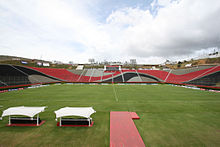
During the last decades, volleyball has grown steadily in Salvador, especially after the gold medal won by Brazil in the 1992 Summer Olympics in Barcelona.[85] The most important tournaments in Bahia are the State Championship, the State League tournament and the Primavera Games, and the main teams are Associação Atlética da Bahia, Bahiano de Tênis, and Clube the Regatas Itapagipe. There are also beach volleyball events. Salvador has housed many international tournaments. Federação Bahina de Voleibol (the state league) can inform the schedule of tournaments. Bowling is practiced both by teenagers and adults in Salvador. Boliche do Aeroclube and Space Bowling are equipped with automatic lanes as well as a complete bar infrastructure.

Bahia's basketball league exists since 1993 and has 57 teams. The sport is very popular in the city of Salvador, especially among students.[86] There are several courts scattered across the city, where is possible to play for free, like the one located at Bahia Sol square, where people play.[87] There are also several gymnasiums, in clubs like Bahiano de Tênis and Associação Atlética and the Antonio Balbino Gymnasiums (popularly known as "Balbininho"), which is an arena that can hold up to 7,000 people.
Todos os Santos Bay and Salvador's climatic conditions are ideal for competition and recreational sailing. The city is equipped with good infrastructure for practice of sailing, such as rental and sale of dock space, boat maintenance, restaurants, snack bar, convenience stores, nautical products stores, boat rental agencies, VHF and SSB communication systems, events, and total assistance to crews.[88] The large number of sailing events organized by clubs and syndicates, like oceanic races and typical boats (wooden fishing boats and canoes) races, demonstrates the sport's growing force. Currently, Salvador has a national racing schedule with dozens of events, also receiving the Mini Transat 6.50 and Les Illes du Soleil races.[89]
Rowing boat races started in the city more than a hundred years ago.[90] It was originally practiced by young men from traditional families, who spent their summer vacations there. The sport is a leisure option in Cidade Baixa (the lower part of the city). Esporte Clube Vitória and Clube São Salvador were the pioneers in the sport. Nowadays, these two entities and also Clube de Regatas Itapagipe lead the competitions that take place in the city. With the recent renovation of the Dique do Tororó area, Salvador received new lanes for the practice of the sport.
Notable residents



- Acelino Freitas, boxer.
- Adriana Ferreyr, actress.
- Adriana Lima, supermodel.
- Antônio Carlos Magalhães, politician.
- Antônio Carlos Vovô, leader of Ilê Aiyê Afro Bloco.
- Antônio Rodrigo Nogueira, (Minotauro), MMA fighter.
- Bebeto Gama, football forward.
- Caetano Veloso, musician.
- Carlinhos Brown, singer.
- Castro Alves, poet.
- Cláudia Leitte, singer.
- Daniela Mercury, musician.
- Dante Bonfim Costa Santos, professional footballer.
- Dias Gomes, playwright.
- Dorival Caymmi, singer.
- Edvaldo Valério, swimmer.
- Elsimar M. Coutinho, scientist and professor.
- Gal Costa, singer.
- Gilberto Gil, singer.
- Glauber Rocha, movie director.
- Gregório de Mattos, poet.
- Irmã Dulce, Catholic nun.
- Ivete Sangalo, singer.
- João Gilberto, musician.
- João Ubaldo Ribeiro, writer.
- Jorge Amado, writer.
- Junior Dos Santos, mixed martial artist.
- Lateef Crowder Dos Santos, Capoeira practitioner
- Lázaro Ramos, actor.
- Lyoto Machida, mixed martial artist.
- Manuel dos Reis Machado (Bimba), capoeira master.
- Marcos Andre Batista Santos (Vampeta), soccer player.
- Margareth Menezes, singer.
- Maria Bethânia, singer.
- Milton Santos, geograph.
- Nelson de Jesus Silva (Dida), soccer goalkeeper.
- Oscar Freire, physician and professor.
- Paquito, musician.
- Pitty, musician.
- Priscila Fantin, actress
- Raul Seixas, musician.
- Ricardo Santos, beach volleyball player.
- Ruy Barbosa de Oliveira, writer, jurist and politician.
- Simone Bittencourt, singer.
- Tom Zé, musician.
- Tony Kanaan, race car driver.
- Vicente Ferreira Pastinha, capoeira master.
- Wagner Moura, actor.
Twin towns – Sister cities
Salvador's Twin towns and Sister cities are:[91]
| Country | City | State / Region | Since |
|---|---|---|---|
| 1962[91] | |||
| 1985[91][92][93] | |||
| 1985[91] | |||
| 1985[91] | |||
| 1987[91] | |||
| 1992[91] | |||
| 1993[91] | |||
| File:Sciacca-Stemma.png Sciacca | 2001[91] | ||
| File:哈尔滨市徽.jpg Harbin | 2003[91] | ||
| 2006[94] |
See also
References
- ^ [1][dead link]
- ^ The European Portuguese pronunciation is [saɫvɐˈdoɾ (ðɐ bɐˈi.ɐ)]
- ^ Brickell, Margaret (July 1991). "If You Only Have a Day in Salvador da Bahia". Cruise Travel. 13 (1): 25–26. Retrieved 29 April 2011.
- ^ Graham, Sandra Lauderdale (2002). Caetana says no: women's stories from a Brazilian slave society. Cambridge: Cambridge University Press. p. 3. ISBN 0-521-89353-4.
{{cite book}}:|access-date=requires|url=(help) - ^ Salvador - A Primeira Capital do Brasil Template:Pt icon
- ^ "População residente, por situação do domicílio e sexo - Aglomerados urbanos - Brasil". Brazilian Institute of Geography and Statistics. Retrieved 12 June 2014.
- ^ Confira o ranking das maiores regiões metropolitanas Template:Pt icon
- ^ Carnaval de Salvador Template:Pt icon
- ^ Salvador metropolitan area and African Culture Template:Pt icon
- ^ Centro Histórico da cidade de Salvador Template:Pt icon
- ^ All Saints Bay Template:Pt icon
- ^ Recôncavo Baiano Template:Pt icon
- ^ Geography (PDF). Salvador, Brazil: Aloveworld. 2006. ISBN 85-240-3919-1. Retrieved 18 July 2007.
- ^ Cidade Alta e Baixa Template:Pt icon
- ^ Top 10 beaches of the world Template:En icon
- ^ Arena Fonte Nova Template:Pt icon
- ^ The Twelfth United Nations Congress on Crime Prevention and Criminal Justice Template:En icon
- ^ http://www.climatefinder.com/places/SBSV
- ^ "13th International RIdIM Conference & 1st Brazilian Conference on Music Iconography - Salvador 2011". Ridim-br.mus.ufba.br. Retrieved 27 January 2014.
- ^ "History of Salvador". Salvadorcentral.com. Retrieved 27 January 2014.
- ^ "Salvador Brazil". Willsafe.org. 28 January 1951. Retrieved 27 January 2014.
- ^ tudobeleza (15 July 2008). "Salvador da Bahia – First National Capital". Eyes On Brazil. Retrieved 27 January 2014.
- ^ "Zumbi dos Palmares Monument Marker". Hmdb.org. Retrieved 27 January 2014.
- ^ [2][dead link]
- ^ Cite error: The named reference
DailyMeanC_INMETwas invoked but never defined (see the help page). - ^ Cite error: The named reference
Humidity_INMETwas invoked but never defined (see the help page). - ^ Cite error: The named reference
Rainfall_INMETwas invoked but never defined (see the help page). - ^ "2010 IGBE Census" (in Portuguese). Censo2010.ibge.gov.br. Retrieved 27 January 2014.
- ^ a b "2010 IGBE Census" (in Portuguese). Censo2010.ibge.gov.br. Retrieved 27 January 2014.
- ^ The largest Brazilian cities - 2010 IBGE Census (in Portuguese)
- ^ FROMMER'S (20 November 2006). "Introduction to Bahia - New York Times". Travel.nytimes.com. Retrieved 17 April 2010.
{{cite news}}: CS1 maint: multiple names: authors list (link) CS1 maint: numeric names: authors list (link) - ^ http://web2.sbg.org.br/congress/sbg2008/pdfs2008/23959.pdf
- ^ "Barsa Planeta Ltda". Brasil.planetasaber.com. Retrieved 17 April 2010.
- ^ "Religion in Salvador by IBGE". IGBE. Retrieved 11 October 2012.
- ^ Economy of Salvador Template:En icon
- ^ About Salvador[dead link]
- ^ "Salvador - Great Cities (U.S. Website)". Great Cities. Retrieved 17 April 2010.
- ^ "Praias de Salvador Bahia Praias do Brasil: Brasil, Praias do Rio, do Nordeste e outras praias do Brasil". Topdobrasil.com.br. Retrieved 27 January 2014.
- ^ Gerador Automático de Meta-Tags <http://buscas.com.br/meta-tags>. "Historic Churches in Pelourinho". Visiteabahia.com.br. Retrieved 17 April 2010.
{{cite web}}: External link in|author= - ^ "Folha Online - Growth in construction has attracted many international investors". .folha.uol.com.br. 1 January 1970. Retrieved 17 April 2010.
- ^ "Car Models - Ford Bahia". Parana-online.com.br. Retrieved 17 April 2010.
- ^ Ford Motor Company in Salvador Metropolitan Area Template:Pt icon
- ^ "Jac Motors in Bahia" (in Portuguese). G1.globo.com. 16 November 2011. Retrieved 27 January 2014.
- ^ "Monsanto Company in Salvador" (in Portuguese). Pautasocial.com.br. 8 November 2011. Retrieved 27 January 2014.
- ^ Do G1, em São Paulo. "2013 GDPs" (in Portuguese). Terra.com. Retrieved 24 March 2014.
{{cite web}}: CS1 maint: numeric names: authors list (link) - ^ http://www.bahiaja.com.br/economia/noticia/2013/12/17/ibge-salvador-ocupa-22-lugar-no-ranking-per-capita-do-pib2011,67361,0.html#.UzCwKyC5fIU GDP per capita by city Template:Pt icon
- ^ "Salvador Shopping, o segundo mais bonito do mundo" (in Portuguese). Bahiamercantil.com.br. Retrieved 27 January 2014.
- ^ "Tourism in Salvador". Traveleye.com. Retrieved 27 January 2014.
- ^ Projecto Brazil (25 July 2008). "Tourism in Salvador". Projectobrazil.blogspot.com.br. Retrieved 27 January 2014.
- ^ Gavin McOwan (16 February 2007). "Top 10 beaches of the world | Travel". London: guardian.co.uk. Retrieved 17 April 2010.
- ^ "Salvador Guide Information". Drhostel.com. 12 February 2008. Retrieved 27 January 2014.
- ^ "Salvador: tourism and recreation". 360brazil.co.uk. 3 February 2013. Retrieved 27 January 2014.
- ^ "Top High schools of Salvador". Jestudante.blogspot.com.br. Retrieved 5 July 2012.
- ^ Projecto Brazil (25 July 2008). "Projecto Brazil". Projectobrazil.blogspot.com. Retrieved 27 January 2014.
- ^ "New Pelourinho". Gosouthamerica.about.com. 5 March 2010. Retrieved 17 April 2010.
- ^ Brazil, Projecto (25 July 2008). "Portuguese language in the Baroque era". Projectobrazil.blogspot.com. Retrieved 17 April 2010.
- ^ Culture in Salvador Template:En icon
- ^ "Religion Salvador" (in Portuguese). Touristlink.com.br. Retrieved 27 January 2014.
- ^ "1st bishop in Brazil". Darwin-online.org.uk. 14 May 2013. Retrieved 27 January 2014.
- ^ a b c Salvador - Religion Template:En icon
- ^ "Religion in Salvador". Medlibrary.org. Retrieved 27 January 2014.
- ^ Cuisine of Salvador Template:En icon
- ^ "Cuisine - Salvador" (in Portuguese). Touristlink.com.br. Retrieved 27 January 2014.
- ^ "Caopeira". Travelblog.org. 9 June 2011. Retrieved 27 January 2014.
- ^ "Capoeira Information". Brazilplaces.com. Retrieved 17 April 2010.
- ^ Rohter, Larry (18 September 2012). "Brazil's Pied Piper of Street Art". The New York Times. Retrieved 17 September 2013.
- ^ "Carnaval of Salvador". Home.centraldocarnaval.com.br. Retrieved 17 April 2010.
- ^ "Numbers of Carnival - Salvador". Translate.google.com. Retrieved 17 April 2010.
- ^ Brooke, James (14 February 1993). "Carnival of Salvador in The". New York Times. Retrieved 17 April 2010.
- ^ Osmundo Pinho. "Ethnographies of the Brau: body, masculinity and race in the reafricanization in Salvador." In Estudos Feministas. 2006. University of Campinas
- ^ "Tomé de Souza in Salvador". Muse.jhu.edu. Retrieved 17 April 2010.
- ^ "Salvador Culture". Archive.is. 12 February 2008. Retrieved 27 January 2014.
- ^ Salvador Information Template:En icon
- ^ "Model Market of Salvador". Portalmercadomodelo.com.br. Retrieved 17 April 2010.
- ^ "Aeroporto de Salvador" (PDF). Retrieved 2014.
{{cite web}}: Check date values in:|accessdate=(help) - ^ "Salvador Metro". Findarticles.com. 2001. Retrieved 17 April 2010.
- ^ nosso time. "2014 FIFA World Cup" (in Portuguese). Portal2014.org.br. Retrieved 27 January 2014.
- ^ Brasil 24/7. "New buses of Salvador" (in Portuguese). Brasil247.com. Retrieved 27 January 2014.
{{cite web}}: CS1 maint: numeric names: authors list (link) - ^ "Salvador City Hall - Number of Vehicles". Sim.salvador.ba.gov.br. Retrieved 17 April 2010.
- ^ "Bus in Salvador" (in Portuguese). Correio24horas.com.br. Retrieved 27 January 2014.
- ^ "Bus station - Salvador". Virtualtourist.com. Retrieved 27 January 2014.
- ^ "Neighborhoods of Salvador". Salvadorcentral.com. Retrieved 27 January 2014.
- ^ "Liberdade Neighborhood". Smec.salvador.ba.gov.br. Retrieved 17 April 2010.
- ^ http://www.triposo.com/loc/Salvador2C_Bahia/sports Sports in Salvador Template:En icon
- ^ http://www.triposo.com/loc/Salvador2C_Bahia/sports Sports in Salvador Template:En icon
- ^ "Basketball in Salvador". Asbacsalvador.com.br. Retrieved 17 April 2010.
- ^ "Brazilian Federation of Basketball". Digidata.com.br. Retrieved 17 April 2010.
- ^ Salvador - 2014 soccer World Cup Host City Template:En icon
- ^ Salvador - 2014 soccer World Cup Host City Template:En icon
- ^ "Rowing boat in Salvador". Campos.rj.gov.br. Retrieved 17 April 2010. [dead link]
- ^ a b c d e f g h i j "Mayor's International Council Sister Cities Program". Salvador, Bahia. Retrieved 17 August 2008.
- ^ "Lisboa - Geminações de Cidades e Vilas". Associação Nacional de Municípios Portugueses [National Association of Portuguese Municipalities] (in Portuguese). Retrieved 23 August 2013.
{{cite web}}: Unknown parameter|trans_title=ignored (|trans-title=suggested) (help) - ^ "Acordos de Geminação, de Cooperação e/ou Amizade da Cidade de Lisboa". Camara Municipal de Lisboa (in Portuguese). Retrieved 23 August 2013.
{{cite web}}: Unknown parameter|trans_title=ignored (|trans-title=suggested) (help) - ^ Miami and Salvador are Sister Cities
External links
- Pelourinho of Salvador, Bahia Digital Media Archive (creative commons-licensed photos, laser scans, panoramas), data from a Federal University of Bahia/University of Ferrara/Leica Geosystems/CyArk research partnership
- Template:En icon Template:Fr icon Template:Du icon City website
- The City of Salvador is a map from 1671 by Arnoldus Montanus Template:En icon Template:La icon


